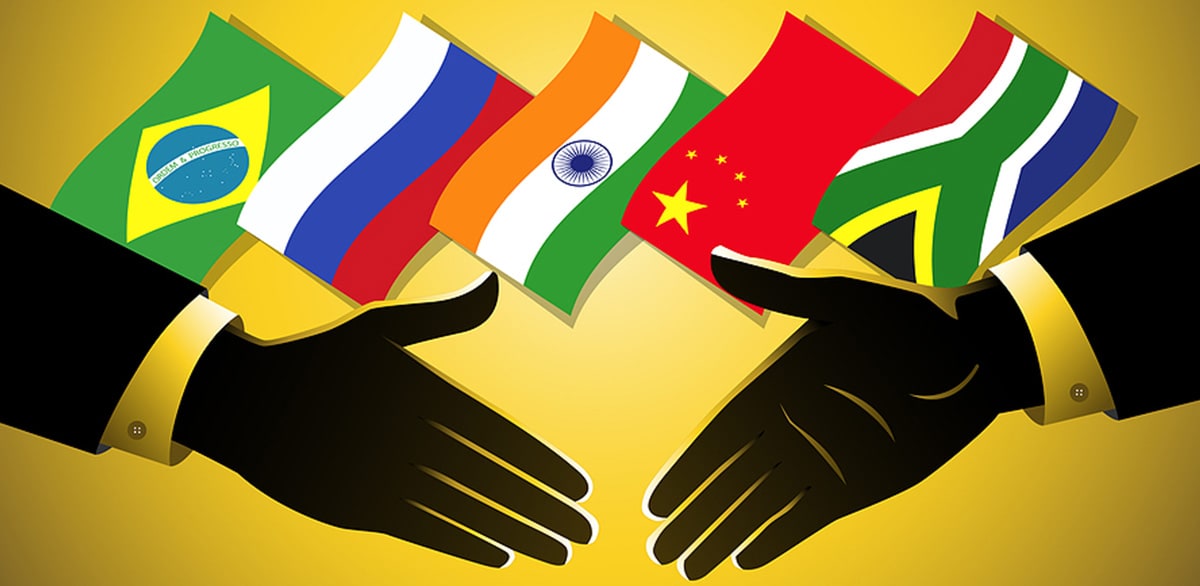
The BRICS nations – currently comprised of Brazil, Russia, India, China, and South Africa – more than doubled their roster this week with the inclusion of six new members. This decisive move underscores the group’s commitment to expansion and furthers their cause against US hegemony.
Who joined BRICS in 2023?

Within the first day of the 15th annual BRICS Summit, the bloc announced the addition of Argentina, Egypt, Ethiopia, Iran, Saudi Arabia, and the United Arab Emirates (UAE). These countries will officially achieve full membership on January 1, 2024. The most significant effects of this expansion might be delayed, but the sudden and expansive growth of the BRICS reflects global support for a restructuring of the global economy. As the current world reserve currency, the dollar is the inevitable target of attack.
BRICS Pursue Future Growth
In the span of a few decades, what started out as a loose collection of emerging economies has exploded into the fastest-growing and largest economic bloc in the world. The most recent admission of six more nations indicates a new phase of growth for the BRICS group. Although only a select few countries were brought into the fold, over twenty countries formally applied to join.
Following the group’s decision, Brazilian President Luiz Inácio Lula da Silva said the BRICS nations “will remain open to new candidates.”1 The five BRICS nations might have led the summit, but nearly 50 additional government representatives and heads of state tagged along, illustrating the group’s mass appeal.
What are the implications of the BRICS expansion?
The BRICS nations already comprise over 41% of the world’s population and far outproduce the G7 in terms of GDP. Comparatively, some of the most recent admits have small populations and weak economies, leaving many to wonder how this move will impact the global economic order. In reality, the BRICS expansion is much more than a symbolic gesture. It could have disastrous consequences for US hegemony and the dollar’s value for a number of reasons.
The BRICS now has an anti-US tilt.
In its original form, the BRICS nations represented a contradictory mix of long-term allies and historical enemies of the US. This ambiguity gave the group plausible deniability when it came to its alleged hostility toward America, although leaders never shied away from their mission to topple Western influence. However, the inclusion of Iran gives the group an undeniable anti-US tilt which only magnifies the target on America’s back.
The effects of sanctions are weakened.
The BRICS nations have come under scrutiny for providing a loophole to global sanctions. It’s no secret that Russia and China, some of the world’s most consistent violators of international law, have been propping up the BRICS block with the self-interested aim of circumnavigating the stranglehold of Western sanctions. The acceptance of Iran suggests the BRICS bloc embraces its suspected role of aiding and abetting pariah states.
It’s a further threat to the petrodollar
The petrodollar has been the linchpin of USD hegemony ever since the gold standard was abandoned in the 1970s. America’s tight-knit relationship with OPEC nations ensured oil was priced in the greenback. With the admission of Saudi Arabia and the UAE, the BRICS nations dealt a damaging blow to the reigning petrodollar system. US-Middle East ties have never been weaker, and the door is wide open for China to further the rise of the petroyuan.
The BRICS are accelerating de-dollarization.
The BRICS nations didn’t kickstart the process of de-dollarization, but the group has put a tremendous amount of effort into advancing that cause. This massive expansion reveals a growing hunger among world leaders for an alternative to the dollar-dominant economic order. Every country that teams up with the BRICS is actively pushing for a replacement for the US dollar and maximizing the leverage behind that thrust.
Gold prices could see a jump.
The most propitious result of the BRICS expansion is its potential boost to gold prices. The world tends to move into gold as uncertainty and instability elevate. The rapid growth of emerging markets as a direct threat to the reigning reserve currency is bound to rattle confidence in the world order. This is reflected in the record-setting surge in central bank gold demand we’ve seen over the past few years. Plus, the BRICS nations are discussing the creation of a BRICS currency with a gold-backing which would further increase gold demand and, as a result, gold prices.
Stay Updated to Stay Protected
If you’re struggling to keep up with all the happenings in the ever-changing world economy, check out our FREE Petrodollar Timeline. This in-depth report covers the rise, reign, and fall of the dollar and receives routine updates to reflect the most recent trends.


